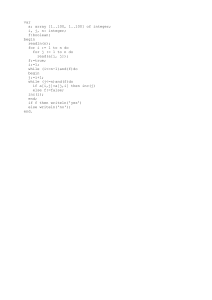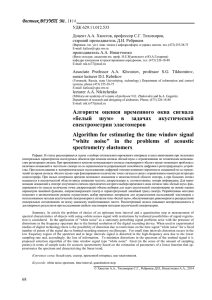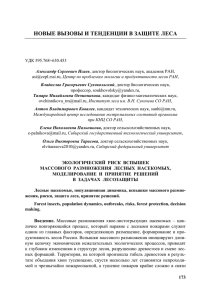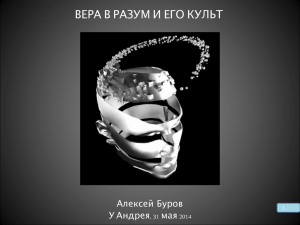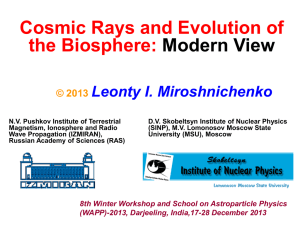Recent Results from the Telescope Array Project, Hanlon 2016
реклама
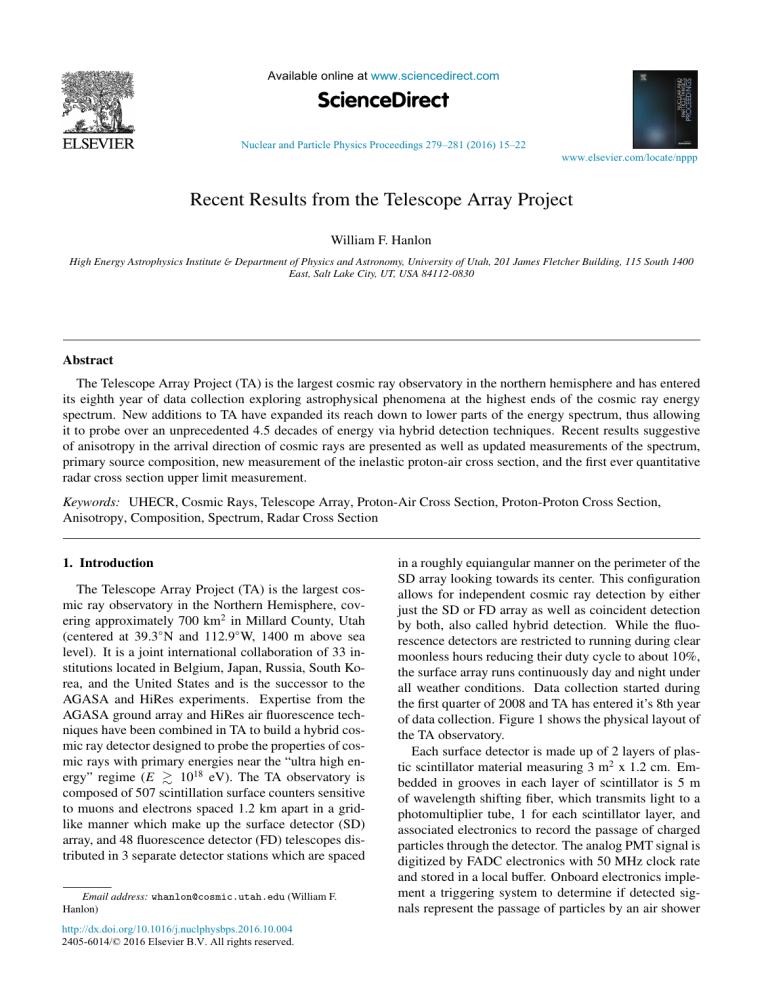
Available online at www.sciencedirect.com Nuclear and Particle Physics Proceedings 279–281 (2016) 15–22 www.elsevier.com/locate/nppp Recent Results from the Telescope Array Project William F. Hanlon High Energy Astrophysics Institute & Department of Physics and Astronomy, University of Utah, 201 James Fletcher Building, 115 South 1400 East, Salt Lake City, UT, USA 84112-0830 Abstract The Telescope Array Project (TA) is the largest cosmic ray observatory in the northern hemisphere and has entered its eighth year of data collection exploring astrophysical phenomena at the highest ends of the cosmic ray energy spectrum. New additions to TA have expanded its reach down to lower parts of the energy spectrum, thus allowing it to probe over an unprecedented 4.5 decades of energy via hybrid detection techniques. Recent results suggestive of anisotropy in the arrival direction of cosmic rays are presented as well as updated measurements of the spectrum, primary source composition, new measurement of the inelastic proton-air cross section, and the first ever quantitative radar cross section upper limit measurement. Keywords: UHECR, Cosmic Rays, Telescope Array, Proton-Air Cross Section, Proton-Proton Cross Section, Anisotropy, Composition, Spectrum, Radar Cross Section 1. Introduction The Telescope Array Project (TA) is the largest cosmic ray observatory in the Northern Hemisphere, covering approximately 700 km2 in Millard County, Utah (centered at 39.3◦ N and 112.9◦ W, 1400 m above sea level). It is a joint international collaboration of 33 institutions located in Belgium, Japan, Russia, South Korea, and the United States and is the successor to the AGASA and HiRes experiments. Expertise from the AGASA ground array and HiRes air fluorescence techniques have been combined in TA to build a hybrid cosmic ray detector designed to probe the properties of cosmic rays with primary energies near the “ultra high energy” regime (E 1018 eV). The TA observatory is composed of 507 scintillation surface counters sensitive to muons and electrons spaced 1.2 km apart in a gridlike manner which make up the surface detector (SD) array, and 48 fluorescence detector (FD) telescopes distributed in 3 separate detector stations which are spaced Email address: whanlon@cosmic.utah.edu (William F. Hanlon) http://dx.doi.org/10.1016/j.nuclphysbps.2016.10.004 2405-6014/© 2016 Elsevier B.V. All rights reserved. in a roughly equiangular manner on the perimeter of the SD array looking towards its center. This configuration allows for independent cosmic ray detection by either just the SD or FD array as well as coincident detection by both, also called hybrid detection. While the fluorescence detectors are restricted to running during clear moonless hours reducing their duty cycle to about 10%, the surface array runs continuously day and night under all weather conditions. Data collection started during the first quarter of 2008 and TA has entered it’s 8th year of data collection. Figure 1 shows the physical layout of the TA observatory. Each surface detector is made up of 2 layers of plastic scintillator material measuring 3 m2 x 1.2 cm. Embedded in grooves in each layer of scintillator is 5 m of wavelength shifting fiber, which transmits light to a photomultiplier tube, 1 for each scintillator layer, and associated electronics to record the passage of charged particles through the detector. The analog PMT signal is digitized by FADC electronics with 50 MHz clock rate and stored in a local buffer. Onboard electronics implement a triggering system to determine if detected signals represent the passage of particles by an air shower 16 W.F. Hanlon / Nuclear and Particle Physics Proceedings 279–281 (2016) 15–22 Figure 1: Location of the Telescope Array SDs and FD stations. Each red diamond is one of 507 surface counters and the blue hexagons show the locations of the FD stations which all look in toward the SD array. Yellow stars indicate SD communication towers and the CLF is a calibration laser located equidistant from each FD station. based upon the signal expected from a minimum ionizing particle. When the trigger threshold for a single SD station is passed, the SD communicates via wireless LAN to one of three communication towers placed around the ground array. Event level triggers are generated by electronics in the communication towers which can direct all SDs that have detected a low level trigger to send their data for storage and event construction. Event data is sent from the communications towers to a central computing facility located nearby and the data is then collected and written to computer hard drives for further analysis. GPS timing is used by each SD station to record the time of each trigger and to record the relative timing of triggers between other SDs and the FD stations as well in the event of a hybrid event. The SD array trigger efficiency is nearly 100% for air showers with energies in excess of 1019 eV and zenith angles below 45◦ [1]. Three FD stations, named Middle Drum FD, Black Rock FD, and Long Ridge FD, overlook the SD array. Each FD station is located about 35 km away from each other around the perimeter of the array. Near the center of the SD array is a central laser facility (CLF) and each FD station is located 21 km away from it. The CLF is used for energy scale calibration between the different stations and to study aerosol distributions in the atmo- sphere. Middle Drum FD uses the mirrors and electronics of the HiRes1 fluorescence detector from the HiRes experiment, while Black Rock FD and Long Ridge FD were constructed as new FD stations for the TA project. Reutilizing the HiRes1 equipment allows TA to relate the energy scale of previous measurements from the HiRes experiment to new results measured by TA. There are 14 telescopes viewing 112◦ in azimuth arranged in 2 rings of zenith angle coverage. Ring 1 telescopes observe between 3◦ - 17◦ and ring 2 telescopes observe between 17◦ - 31◦ in zenith angle. Each telescope’s 5.2 m2 mirror collects and reflects light onto a cluster of 256 PMTs arranged into a tightly packed 16x16 hexagonal array with each pixel viewing about a 1◦ cone of the sky. Black Rock FD and Long Ridge FD utilize 12 telescopes at each station with similar sky coverage as Middle Drum. Black Rock and Long Ridge FDs utilize FADC electronics to digitize and record light they observe, while Middle Drum employs a sample and hold electronics design. Operation of the Telescope Array Low Energy Extension (TALE) began in May 2013. TALE uses 10 FD telescopes pointed up into a higher zenith angle configuration than the other TA FD stations. 5 mirrors each make up a ring 3 and ring 4 viewing a total zenith angle range of 31◦ - 57◦ and 100◦ in azimuth. TALE is colocated with the Middle Drum FD effectively giving that station a zenith angle coverage of 3◦ - 57◦ zenith angle coverage of some low energy events. A closeby infill array of SD counters with 400 m spacing is also part of the TALE detector design. There are 31 counters are in place with 16 counters currently operational. TALE was designed to record events in the cosmic ray spectrum down to the region just above the knee (∼ 1016.5 eV) and as high as the ankle (∼ 1018.5 eV). TALE can also be operated as a hybrid detector combining coincident events measured by the infill array as well as the FD station or independently as only an FD station. 2. Spectrum The cosmic ray energy spectrum can be observed by TA either independently by the SD array or the FD array. Observations can also be combined between the SD array and the FD array (hybrid observation) or can also be combined between multiple independent FD stations (so-called stereo or triple events). Measurements made by combining the different elements can greatly improve the determination of important air shower parameters such as event timing and geometry, thereby W.F. Hanlon / Nuclear and Particle Physics Proceedings 279–281 (2016) 15–22 improving the resolution of other observables important to characterizing the properties of an air shower (e.g., primary particle energy, depth of shower maximum, shower arrival direction). The greatest statistical power in the energy spectrum comes from the independent SD array measurement since it has near 100% duty cycle. The TA SD energy spectrum has been reported in the past for 4 years of observation[2] and updates have been presented at International Cosmic Ray Conferences. At the recent 2015 ICRC held in the Hague, the Netherlands the SD energy spectrum was updated to show the measurement using seven years of collected data. Figure 2 shows the preliminary TA energy spectrum using 7 years of data collected using the SD array. The 2 break points indicate changes in the spectral indices and mark the locations of the ankle and the GZK cutoff at log10 (Eankle ) = 18.70 ± 0.02 and log10 (EGZK ) = 19.78 ± 0.06 respectively. The spectral indices are measured to be −3.30 ± 0.03 below the ankle, −2.68 ± 0.03 between the ankle and the GZK break, and −4.55 ± 0.56 above the GZK break. The significance of the GZK cutoff is measured by calculating the significance of the difference in the number of events of the integral spectrum assuming there is no break in the spectrum (Nexpect ) and the actual number of events observed (Nobserve ). Above EGZK , Nexpect is calculated to be 99.3 events and Nobserve is measured to be 44 events leading to a chance probability of measuring this deficit to be 4 × 10−4 , or ∼ 5.5 standard deviations. HiRes reported the first observation of the GZK cutoff using 9 years of monocular FD data with a significance of 5.3 standard deviations[3]. A second way to measure the location of the GZK cutoff is to find the energy where the predicted integral spectrum exceeds twice the number of events in the observed integral spectrum[4]. This energy is called E1/2 . The 7 year SD energy spectrum measures log10 (E1/2 ) = 19.77 ± 0.06 in agreement with that found with the broken power law fit. With the addition of TALE, TA now has the ability to probe the spectrum near the knee. TA can go even lower in energy by taking advantage of a new technique to observe highly inclined air showers by measuring their direct Cherenkov light. As an air fluorescence detector, TALE’s energy threshold is about 1016.5 eV. By observing showers with very small viewing angles, TALE can achieve an energy threshold of about 1015.5 eV. This technique allows TALE to act as a small imaging atmospheric Cherenkov telescope (IACT). By combining these spectrum measurements, TA can measure the primary energy of cosmic rays spanning over 4.5 decades of energy. This is particularly important because we 17 Figure 2: The preliminary 7 year energy spectrum measured by the TA surface detector array. The solid line shows a broken power law fit, where the spectral indices and break points are each fit as independent parameters to the spectrum. have one single experiment in which we can understand our systematics and energy scale to measure the energy of air showers in the energy region from the galatic to extra-galactic transition in cosmic ray flux all the way to the GZK cutoff. By going to lower energies, we are also closing the gap between accelerator energies reachable on earth, such as at the LHC, which will improve our understanding of hadronic physics in these energy ranges. This will, in turn, improve hadronic modeling which is very important to understanding the composition of cosmic rays above the knee. Figure 3 shows four different spectrum measurements using the SD, Black Rock and Long Ridge FD monocular, TALE FD (called TALE bridge), and TALE Cherenkov. This one measurement spans over four decades in energy and observes four distinct features of the cosmic ray spectrum. When fit with a broken power law fit features observed are: a low energy ankle at log10 (E/eV) = 16.34 ± 0.04, a 2nd knee at log10 (E/eV) = 17.30 ± 0.05, the high energy ankle at log10 (E/eV) = 18.72 ± 0.02, and the GZK cutoff at log10 (E/eV) = 19.80 ± 0.05. 3. Composition TA measures primary particle composition via FDs or via hybrid FD-SD observations by measuring the depth of air shower maximum, called Xmax . Because we only observe the secondary particles produced after the primary particle inelastically collides with an air molecule, primary particle composition can only be inferred statistically by observing many showers. By comparing the distribution of Xmax as a function of energy (called Xmax elongation) to Monte Carlo simulations we can estimate 18 W.F. Hanlon / Nuclear and Particle Physics Proceedings 279–281 (2016) 15–22 Figure 3: Combined spectrum of TA using 4 different measurements: 7 year SD, 7 year BR-FD monocular, TALE bridge which measures below 1018.5 eV, and TALE Cherenkov which observes low energy showers dominated by Cherenkov light. The spectrum found by combining all 4 spans over 4 decades in energy. the distribution of primary particles observed. Composition is very important to understanding the sources of cosmic rays as well as their distances from Earth. A TA composition measurement using 5 years of hybrid Middle Drum data has been previously reported[5] and updates have been presented at International Cosmic Ray Conferences. At the recent 2015 ICRC new preliminary composition results were shown using different techniques. The Middle Drum hybrid composition analysis first presented in [5] was updated to include 7 years of data and further refinements to the pattern recognition method were done. This method ensures showers of the highest quality are kept for analysis while also reducing bias introduced by cuts. Figure 4 shows the updated elongation plot. The mean Xmax for each energy bin is shown for data as well as for three models consisting of three different pure primary particles: protons, nitrogen, and iron. As the data shows, by using the means of the Xmax distributions in each energy bin, the composition appears to be dominated by light primary particles. Figure 5 shows the Xmax elongation measured using 2 or more FDs. Each event must be well observed by multiple FD stations for this measurement. The highest statistics measurement of composition by TA is shown in Figure 6 and the results look compatible with the Middle Drum hybrid and stereo measurements. For the 3 different measurements shown Xmax resolution is about 20 g/cm2 with reconstruction biases less than a few grams. Measuring the composition is typically done by examining the first and second moments of the Xmax observed distributions. These distributions are not nor- Figure 4: Xmax elongation using the first 7 years of Middle Drum hybrid data. Data is compared to models consisting of pure protons, nitrogen, and iron. As the mean Xmax in each energy bin shows, the composition appears to be dominated by light primary particles. Figure 5: FD stereo composition measurement from the first 7 years of data. Data is compared to a pure proton and pure iron model. Xmax measured using this technique was required to be well observed by multiple FDs. Figure 6: Black Rock/Long Ridge hybrid composition measurement. Data is compared to a pure proton and pure iron model. Shown are two different hadronic models for each primary species. W.F. Hanlon / Nuclear and Particle Physics Proceedings 279–281 (2016) 15–22 mal distributions due to fluctuations in how the primary particles first interact in the atmosphere and how the cascade of secondary particles develop with increasing depth. Different ways of defining functions to describe Xmax distributions are in use. One example found in [6] describes the distribution as a convolution with a exponential function and a Gaussian function for example. Because of the non-normal nature of Xmax distributions TA has tried a different approach to compare data to models. Instead of collapsing all information of the Xmax distribution into 2 test statistics (mean and width), we instead propose to use a test which uses the entire distribution of both model and data. The Cramér-von Mises criterion is such a test which measures the square of the differences in the cumulative distribution functions being compared[7]. For 2 distributions which have similar shape this squared difference is smaller than for distributions with different shapes. To compare data to models, we apply the Cramér-von Mises test by measuring the overall shift in the whole data distribution that is required to find the minimum value of the test statistic. Figure 7 shows the Cramér-von Mises test applied to data and Monte Carlo models for the Middle Drum hybrid composition measurement shown in Figure 4. For each energy bin and each Monte Carlo model the Xmax distribution data is shifted and the Cramér-von Mises test is applied to find the shift required to maximize the p-value of the test. Because in the true 2 sample test one does not shift either distribution, this measure is used to quantify the agreeement between the 2 distribution shapes and called an “s-value”. Figure 7 shows that the best agreement between data and models is found for a pure proton primary distribution below ∼ log10 (E/eV) = 19.5. Above this energy statistics in the data are too low to make a better measurement. By this test we rule out pure iron as a source of primary particles and nitrogen is disfavored as well. 4. Anisotropy TA has reported recently about indications of medium scale anisotropy in the arrival directions of cosmic rays with energies > 57 EeV south of the supergalactic plane near the Ursa Major cluster[8, 9, 10, 11]. This region has been dubbed the “TA Hotspot”. The highest statistics for the search of cosmic ray sources is provided by the SD array. For this analysis, events with zenith angle up to 55◦ with a loose border cut on the SD array are accepted. This results in an angular resolution of 1.7◦ and energy resolution of about 20%. The search method uses oversampling in circles of 20◦ radius across the sky and measures the significance of the 19 Figure 7: Cramér-von Mises applied to hybrid composition data and 3 different primary particle models. The ordinate shows the amount the entire model distribution needs to be shifted to find the best result. The color key on the left shows the maximum value of the “s-value” obtained. Large s-values indicate good agreement in the 2 distributions after shifting. The colored bands around the proton and iron model lines show the range of shifts required for 4 different hadronic models. excess of events observed compared to events expected for an isotropic source distribution. Details of how the analysis is performed are described in [10]. The previous search reported Non = 19 events recorded over 5 years of data collection in one such circle centered at (α, δ) = (146.7◦ , 43.2◦ ) in equatorial coordinates. The expected background given an isotropic source distribution for a circle this size is Nbg = 4.49 events. This results in a global significance of 3.4σ in the excess of events expected for a distribution of isotropic sources. A new preliminary analysis has been performed to extend the search for anisotropy to 7 years of data. By folding in an additional 2 years of data, 37 new events that pass cuts are added in, giving a total of 109 events. The hotspot signal grows to 24 events with the addition of the new data with 6.88 background events expected. The maximum pre-trial significance of this signal is 5.1σ. Because this measurement does not take into account random clustering, the significance of finding Non events distributed over the isotropic sky is calculated. This is done by throwing 1 million Monte Carlo data sets each containing Non randomly distributed events in the TA field of view for 5 different oversampling radii. The maximum significance for each MC set is recorded. The global significance is found by counting the number of MC sets with maximum significance greater than or equal to the pre-trial test. Doing this it is found that the global excess chance probability is 3.7 × 10−4 or 3.4σ one-sided significance. The 7 year excess significance 20 W.F. Hanlon / Nuclear and Particle Physics Proceedings 279–281 (2016) 15–22 Figure 8: Preliminary locations of events in the TA search of anisotropy. Blue points indicate events found in the previously reported 5 year search and red points show new events by adding in 2 new years of data. 109 events in the 7 year search have be found. The hotspot global excess significance is measured to be 3.4σ for 24 events and expected background of 6.88 Figure 9: Preliminary excess significance map in the TA search for anisotropy using 7 years of data. Oversampling is employed using circles of 20◦ radius and the excess significance compared to an expected isotropic source distribution is shown. The maximum pre-trial significance is measured to be 5.1σ for a circle located at (α, δ) = (148.4◦ , 44.5◦ ). 24 events are found there with 6.88 expected as background. The global excess chance probability is found to be 3.7 × 10−4 or 3.4σ. therefore remains the same as the 5 year significance. 5. Proton-air cross section The first measurement of the TA proton-air cross section has been made[12]. Assuming the Xmax distribution for a given energy bin has a exponential tail with the functional form exp(−Xmax /Λm ), Λm is proportional to the interaction length λp−air [13] which can be related to the cross section by a model dependent K factor, Λm = Kλp−air = K · 14.45mp /σinel p−air . The proportionality factor K is measured by Monte Carlo simulation and is dependent upon the hadronic model used. For this analysis TA determined the K-factor values for 4 of the latest hadronic models available and Figure 10: The first measurement of the TA proton-air cross section. By measuring the depth of Xmax and using the K factor method = 567.0 ± 70.5(stat)+25 σinel −29 (sys) mb at log10 (E/eV) = 18.68 p−air √ ( s = 95 TeV). found a modest 3% model uncertainty among them. The data used for this measurement was 5 years of Middle Drum hybrid. Figure 10 shows the measure+25 ment to be σinel p−air = 567.0 ± 70.5(stat)−29 (sys) mb at log10 (E/eV) = 18.68 √ which corresponds to a center-ofmomentum energy s = 95 TeV. The total proton-proton cross section can be related to the proton-air cross section via Glauber formalism and the Block, Halzen, Stanev (BHS) fit. Using these methods σinel p−air and its errors are propagated to find √ +19 +48 = 170 s = 95 TeV. Figσtotal p−p −44 (stat)−17 (sys) mb at ure 11 shows the TA measurement of σtotal p−p and compares it to accelerator based measurements, previous cosmic ray based measurements, and to the prediction of the BHS fit. 6. Radar Cross Section Telescope Array also has deployed a radar facility (TARA) to test the ability to measure the properties of air showers assuming the plasma density around the core can specularly reflect radio waves of sufficient power, polarization, and frequency. The signal of radio waves reflected from a fast moving highly dense mass of charge would be a “chirp”, which is detected as a rapid change in the sounding frequency over a brief period of time. Simulations of air showers over TA indicate a chirp slope of order ∼-1 MHz/μsec are expected. TARA uses a 25 kW, 54.1 MHz transmitter employing an array of 8 high gain antennae in a bi-static radar fashion to illuminate and detect extended air showers passing over the TA SD array[14]. A radio receiving station located W.F. Hanlon / Nuclear and Particle Physics Proceedings 279–281 (2016) 15–22 21 7. Summary Figure 11: The TA measured proton-proton total cross section as a function of center-of-momentum energy. Previous measurements from cosmic ray experiments, the Tevatron, √ as well as the most recent from the TOTEM experiment at LHC at s = 7 TeV are shown. The dashed line indicates the prediction of the BHS fit. TA measures the +19 +48 cross section to be σtotal p−p = 170−44 (stat)−17 (sys) mb. at the Long Ridge FD records any potential EAS detections by looking for signals that match predetermined chirp rates. Background noise is also recorded through periodic snapshot triggers. The radio receiver may also be forced to synchronously trigger with the local FD. Using 6 months of data, forced FD triggered events in the radio receiver were time matched with events well reconstructed with the Long Ridge FD resulting in 1292 matches. A threshold level of 3 × RMS of background determined from snapshot triggers was used to select those events that had match filter value exceeding this threshold and were considered candidate EAS events. This resulted in 17 events of the 1292 being considered as positive detections. By analyzing the match filter distribution of snapshot events (noise), 17.8 events were expected as background. This is a 60% chance probability of detecting 17 or more events in the signal region, therefore no detection of EAS by radar using this analysis method is yet claimed. An upper limit on the radar cross section (RCS) was measured by simulated echo waveforms on a large set of noise triggers, then simulating the detection response of the radio receiver. The simulated waveforms are scaled by a parameter Γ90 until 90% exceed the detection threshold and the RCS is calculated for the 90% confidence level upper limit. The event with the lowest Γ90 = 0.00077 was an air shower with reconstructed energy of 11.04 EeV corresponding to a RCS of 42 cm2 . This is the first ever quantitative measurement made of an EAS radar cross section upper limit. Telescope Array continues to play a leading role in the field of particle astrophysics by making new important measurements that help broaden our understanding of the cosmos. Our reach in measuring the spectrum now spans over 4.5 decades in energy, allowing one experiment to probe from the just above the knee to the GZK cutoff. One single experiment with the ability to measure 4 distinct features of the PeV and higher range spectrum represents an unprecedented milestone that allows us to examine the transition in the properties of cosmic rays produced in the galaxy to those produced by extra-galactic sources. With only a few months of TALE data and new analysis methods, combined with techniques previously used, we have made preliminary measurements of the energies of a low energy ankle (1016.3±0.04 eV), a second knee (1017.3±0.05 eV), as well as the previously observed high energy ankle (1018.7±0.02 eV), and GZK cutoff (1019.8±0.05 eV). A preliminary high statistics 7 year spectrum using the TA SD array has also improved our measurement of the UHECR spectrum, including a ∼ 6σ confirmation of the GZK cutoff. Composition measurements have been updated to preliminary 7 years of data using Middle Drum hybrid. New analysis has been undertaken by measuring composition using TA FDs in multi-FD mode and a hybrid measurement using the Black Rock and Long Ridge FDs. These multiple methods of measuring composition allows TA to understand the uncertainties in a measurement that is dominated by systematics below the GZK cutoff. TA has also introduced a new method to quantify agreement between data and models by moving beyond the traditional method of reporting the first 2 moments of the Xmax distributions, which can be misleading due to effects in the tails. By using a nonparametric goodness-of-fit test, such as the 2 sample Cramér-von Mises test, a more robust determination of the agreement of data with a particular composition model can be made. Using this method TA rules out pure iron as a source of primary cosmic rays, and TA sees a predominantly light composition below 1019.5 eV. Preliminary new data of the TA hotspot continue to provide hints of possible medium scale anisotropy in the arrival directions of cosmic rays. By extending the search using 2 additional years of data 37 new events over the enitre TA field of view have been collected but the significance of the hotspot in the region of the Ursa Major cluster remains the same at 3.4σ. The first measurement of the proton-air cross section using TA data has been performed. Using 5 years of hybrid data 22 W.F. Hanlon / Nuclear and Particle Physics Proceedings 279–281 (2016) 15–22 +25 σinel p−air is measured to be 567.0 ± 70.5(stat)−29 (sys) mb √ at 1018.68 eV corresponding to s = 95 TeV. The total proton-proton cross section can also be calculated using +19 total +48 σinel p−air and it is found to be σp−p = 170−44 (stat)−17 (sys) mb. Using the TARA facility, a preliminary measurement of the radar cross section of an EAS has been made. Using 6 months of FD triggered triggered data, TARA found a possible 17 events corresponding with possible EAS candidates, but 17.8 events are expected as background (60% chance probability), so no detection is yet claimed. The first ever preliminary measurement of the upper limit of an EAS cross section was performed and found to 42 cm2 (90% c.l.). With the recent approval of the expansion of the TA surface array (TA×4), TA will soon begin deployment of an additional 500 new scintillator SDs. This will provide 20 years of current TA level statistics by the year 2020. Large improvement of statistics of this sort are needed to rapidly answer the question about the true nature of the TA hotspot and to further improve composition measurements especially above 1019.5 eV where statistics rapidly fall. 8. Acknowledgements The Telescope Array experiment is supported by the Japan Society for the Promotion of Science through Grants-in-Aid for Scientific Research on Specially Promoted Research (21000002) “Extreme Phenomena in the Universe Explored by Highest Energy Cosmic Rays” and for Scientific Research (19104006), and the Inter-University Research Program of the Institute for Cosmic Ray Research; by the U.S. National Science Foundation awards PHY-0307098, PHY-0601915, PHY-0649681, PHY-0703893, PHY-0758342, PHY-0848320, PHY1069280, PHY-1069286, PHY-1404495 and PHY1404502; by the National Research Foundation of Korea (2007-0093860, R32-10130, 2012R1A1A2008381, 2013004883); by the Russian Academy of Sciences, RFBR grants 11-02-01528a and 13-02-01311a (INR), IISN project No. 4.4502.13, and Belgian Science Policy under IUAP VII/37 (ULB). The foundations of Dr. Ezekiel R. and Edna Wattis Dumke, Willard L. Eccles, and George S. and Dolores Doré Eccles all helped with generous donations. The State of Utah supported the project through its Economic Development Board, and the University of Utah through the Office of the Vice President for Research. The experimental site became available through the cooperation of the Utah School and Institutional Trust Lands Administration (SITLA), U.S. Bureau of Land Management, and the U.S. Air Force. References [1] T. Abu-Zayyad, et al., The surface detector array of the Telescope Array experiment, Nucl. Instrum. Meth. A689 (2013) 87– 97. arXiv:1201.4964, doi:10.1016/j.nima.2012.05.079. [2] T. Abu-Zayyad, et al., The Cosmic Ray Energy Spectrum Observed with the Surface Detector of the Telescope Array Experiment, Astrophys. J. 768 (2013) L1. arXiv:1205.5067, doi:10.1088/2041-8205/768/1/L1. [3] R. U. Abbasi, et al., First observation of the Greisen-Zatsepin-Kuzmin suppression, Phys. Rev. Lett. 100 (2008) 101101. arXiv:astro-ph/0703099, doi:10.1103/PhysRevLett.100.101101. [4] V. S. Berezinskii, S. I. Grigor’eva, A bump in the ultra-high energy cosmic ray spectrum, A&A199 (1988) 1–12. [5] R. U. Abbasi, et al., Study of Ultra-High Energy Cosmic Ray composition using Telescope Arrays Middle Drum detector and surface array in hybrid mode, Astropart. Phys. 64 (2014) 49–62. arXiv:1408.1726, doi:10.1016/j.astropartphys.2014.11.004. [6] C. J. Todero Peixoto, V. de Souza, J. A. Bellido, Comparison of the moments of the Xmax distribution predicted by different cosmic ray shower simulation models, Astropart. Phys. 47 (2013) 18–30. arXiv:1301.5555, doi:10.1016/j.astropartphys.2013.05.011. [7] T. W. Anderson, On the distribution of the two-sample cramervon mises criterion, Ann. Math. Statist. 33 (3) (1962) 1148– 1159. doi:10.1214/aoms/1177704477. URL http://dx.doi.org/10.1214/aoms/1177704477 [8] A. Aab, et al., Searches for Large-Scale Anisotropy in the Arrival Directions of Cosmic Rays Detected above Energy of 1019 eV at the Pierre Auger Observatory and the Telescope Array, Astrophys. J. 794 (2) (2014) 172. arXiv:1409.3128, doi:10.1088/0004-637X/794/2/172. [9] R. U. Abbasi, et al., A Northern Sky Survey for Point-Like Sources of EeV Neutral Particles with the Telescope Array Experiment, Astrophys. J. 804 (2) (2015) 133. arXiv:1407.6145, doi:10.1088/0004-637X/804/2/133. [10] R. U. Abbasi, et al., Indications of Intermediate-Scale Anisotropy of Cosmic Rays with Energy Greater Than 57 EeV in the Northern Sky Measured with the Surface Detector of the Telescope Array Experiment, Astrophys. J. 790 (2014) L21. arXiv:1404.5890, doi:10.1088/2041-8205/790/2/L21. [11] T. Abu-Zayyad, et al., Correlations of the Arrival Directions of Ultra-high Energy Cosmic Rays with Extragalactic Objects as Observed by the Telescope Array Experiment, Astrophys. J. 777 (2013) 88. arXiv:1306.5808, doi:10.1088/0004-637X/777/2/88. [12] R. U. Abbasi, et al., Measurement of the proton-air cross section with Telescope Arrays Middle Drum detector and surface array in hybrid mode, Phys. Rev. D92 (3) (2015) 032007. arXiv:1505.01860, doi:10.1103/PhysRevD.92.032007. [13] R. W. Ellsworth, T. K. Gaisser, T. Stanev, G. B. Yodh, Ultrahigh-energy cross section from study of longitudinal development of air showers, Phys. Rev. D 26 (1982) 336–339. doi:10.1103/PhysRevD.26.336. URL http://link.aps.org/doi/10.1103/PhysRevD.26.336 [14] R. Abbasi, et al., Telescope Array Radar (TARA) Observatory for Ultra-High Energy Cosmic Rays, Nucl. Instrum. Meth. A767 (2014) 322–338. arXiv:1405.0057, doi:10.1016/j.nima.2014.08.015.
